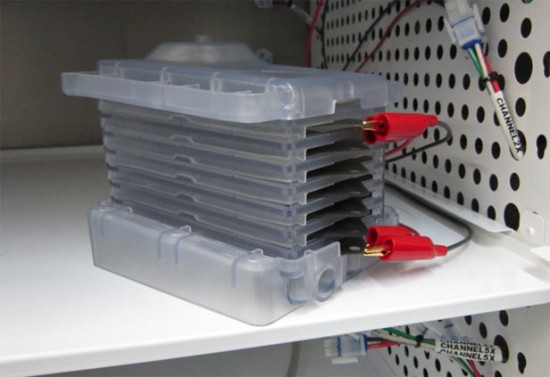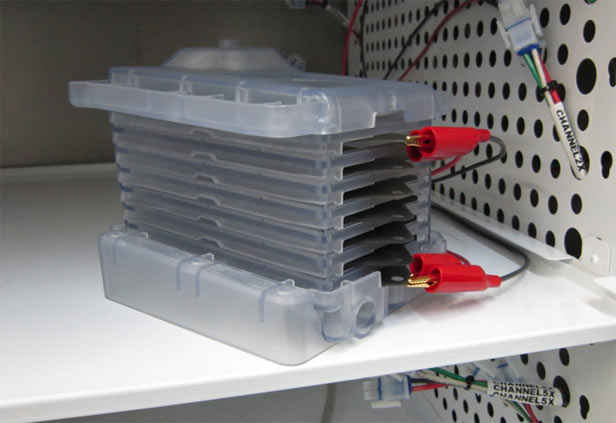Sustainable Energy
Startup Promises a Revolutionary Grid Battery
Eos Energy Storage says its zinc-air battery can store energy to meet peak power needs for less.



Battery developer Eos Energy Storage claims to have solved key problems holding back a battery technology that could revolutionize grid energy storage. If the company is right, its zinc-air batteries will be able to store energy for half the cost of additional generation from natural gas—the method currently used to meet peak power demands.
Company officials say that current prototypes demonstrate twice the energy density of lithium-ion batteries. They claim their final product will last for 30 years in grid-scale applications with a cycle life that is orders of magnitude greater than that of lead-acid batteries, making it one of the longest-lasting battery types around. CEO Michael Oster says Eos will soon complete a $10 million round of funding from several investors.
“If they can get what they are claiming, it would be revolutionary,” says Steve Minnihan, an analyst with Lux Research, who says the technology shows promise for both grid storage and electric vehicles.
Zinc-air technology has long attracted battery developers because it’s safe, it’s inexpensive, and it offers high energy densities. Unlike conventional batteries, in which all reactants are packaged within the battery, zinc-air cells draw in oxygen from the air to generate current. Drawing on outside air gives the batteries a higher capacity-to-volume ratio and lowers the material costs. The battery’s water-based chemistry also means it isn’t prone to catching fire, unlike lithium-ion batteries.
Until now, however, these batteries have had low efficiencies and short life cycles, limiting their use to small, nonrechargeable applications such as hearing aids. Eos officials say they have solved several problems that have confounded previous efforts.
Eos’s key advances involve changes in electrolyte chemistry and cell design. Zinc-air batteries typically use potassium hydroxide, a basic solution that absorbs carbon dioxide from the air. That causes potassium carbonate to build up, slowly clogging the cell’s air pores. Because Eos’s batteries use a novel pH-neutral electrolyte, Oster says, they do not absorb carbon dioxide. The company also uses a unique horizontal cell configuration that relies on gravity rather than a physical membrane to separate the liquid electrolyte from the air. The change, he says, prevents buildups on the zinc electrode from rupturing the membrane and causing cell failure.
Oster says the company has achieved more than 2,700 cycles with no physical degradation in a one third kilowatt-scale battery. In comparison, ReVolt Technology, a leading competitor pursuing similar technology, hopes to reach 1,000 cycles by 2013. Minnihan, however, says Eos still has a long way to go to reach its goal of 10,000 cycles and megawatt-scale batteries.
Oster says the company aims to sell megawatt-scale batteries with six hours of storage capacity at a capital cost of $160 per kilowatt-hour. By storing electricity when demand is low, he says, the batteries should be able to provide electricity at times of peak demand for 12 to 17 cents per kilowatt-hour, compared with 22 to 30 cents per kilowatt-hour for electricity produced by a natural-gas plant.
Jeff Dahn, a professor of physics and chemistry at Dalhousie University, says if the company has solved the electrolyte and membrane problems, it should be a significant step forward for zinc-air batteries. “But show us the data,” he says. “None of this has been shown.”
Dahn also says the maximum efficiency of a zinc-air battery—in terms of the amount of electricity that goes in versus the amount that comes out—is only 60 percent, compared with roughly 80 percent for lead-acid batteries and more than 95 percent for lithium-ion batteries. He says the low efficiency is the result of differences in voltage between charging and discharging and is inherent to the battery type.
Eos claims to have found ways to resolve the differences in voltage and increase efficiency, but Dahn is not convinced. “A lot of people have worked for a long time on rechargeable zinc-air and [the efficiency issue] hasn’t been cracked yet,” he says.